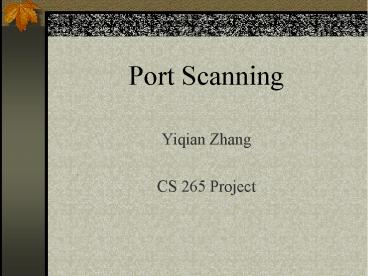Port Scanning - PowerPoint PPT Presentation
Title:
Port Scanning
Description:
Echo: 7/tcp ftp-data: 20/udp. Non Standard Ports: 1023 and above. Yahoo: 5010 Yahoo! Messenger. Port Scanning Techniques. Vanilla: Simplest form of port scan. ... – PowerPoint PPT presentation
Number of Views:377
Avg rating:3.0/5.0
Title: Port Scanning
1
Port Scanning
- Yiqian Zhang
- CS 265 Project
2
What is Port Scanning?
- port scanning is equivalent to knocking on the
walls to find all the doors and windows. - determine what systems are listening reachable
from the Internet . - Analyzing underlying weaknesses.
- Using the weakness for later use.
3
Port Numbers
- Well Known Ports
- 0 1023
- Echo 7/tcp ftp-data 20/udp
- Non Standard Ports
- 1023 and above
- Yahoo 5010 Yahoo! Messenger
4
Port Scanning Techniques
- Vanilla
- Simplest form of port scan.
- Tries each of the ports 65535 on the victim.
- sending a carefully constructed packet.
- with a chosen port number.
5
Stealth Scan
- Port scanning is easily logged by the services
listening at the ports. - Designed to go undetected by auditing tools.
- Scanning at a slow pace.
- inverse mapping
- Generating "host unreachable" ICMP-messages for
IPs that do not exist.
6
TCP Scanner
- TCP connect scan
- Complete a three-way handshake.
- TCP SYN scan
- Half-open scanning.
- A SYN packet is sent.
- A listening target respond with a SYNACK.
- A non-listening target respond with a RST.
- TCP FIN scan
- Scanner sends a FIN packet.
- Closed ports reply with a RST.
- Open ports ignore the packet entirely.
7
Bounce Scans
- The ability to hide tracks is important to
attackers. - FTP bounce scan
- allows the hacker to force the FTP server to do
the port scan and send back the results. This
bouncing through an FTP server hides where the
attacker comes from. - The advantage to this approach is harder to
trace. The disadvantages are that it is slow.
8
UDP Scanning
- In order to find UDP ports, the attacker
generally sends empty UDP datagrams. If - The port is listening, the service should send
back an error message or ignore the incoming
datagram. - The port is closed, then most operating systems
send back an "ICMP Port Unreachable" message.
Thus determine which ports are open. - Neither UDP packets nor the ICMP errors are
guaranteed to arrive, so UDP scanners must also
implement retransmission of packets that appear
to be lost.
9
Port Scanning Tools
- Strobe
- TCP port scanning utility.
- One of the fastest and most reliable TCP scanners
available. - Only looking for those services the attacker
knows how to exploit. - CMD Strobe 192.168.1.10
- Output 192.168.1.10 ssh 22/tcp secure shell
10
Port Scanning Tools
- nmap
- Widely known port scanner.
- Utility for port scanning large networks,
although it works fine for single hosts. - The guiding philosophy for the creation of nmap
was TMTOWTDI (There's More Than One Way To Do
It). - CMD nmap sS 192.168.1.1
- Output Port State Protocol Service
- 21 open tcp
ftp
11
Port Scanning Tools
- netcat
- The Swiss army knife in our security toolkit.
- Provides basic TCP and UDP port scanning
capabilities. By default, netcat uses TCP ports,
so for UDP scanning, we need to specify the u
option. For example, - CMD netcat v z w2 192.168.1.1 1-140
- Output 192.168.1.1 25 (smtp) open
12
Conclusion
- Has legitimate uses in managing networks.
- Can also be malicious in nature if someone is
looking for a weakened access point to break into
your computer. - It is rude to scan someone else's hosts or
networks without the explicit permission of the
owner. - Always ask if it'd be okay to scan outside of
your own networks.

